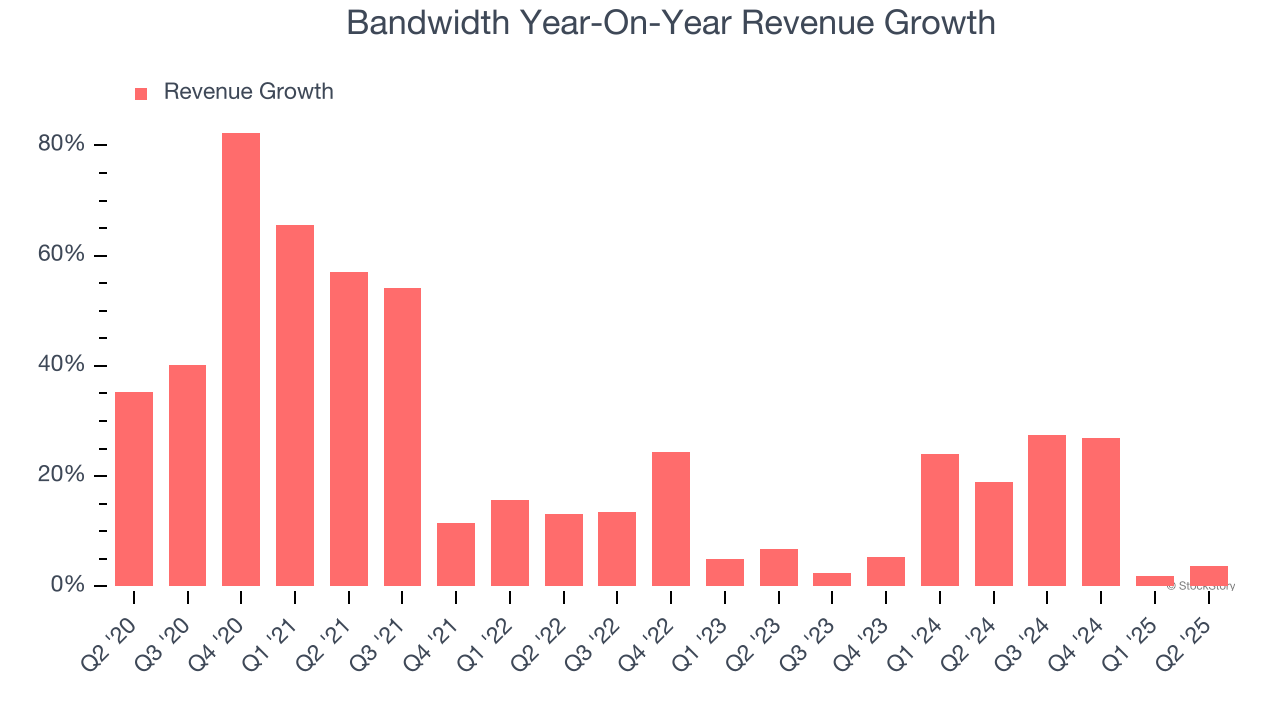
Bandwidth trades at $17.88 per share and has stayed right on track with the overall market, gaining 18.5% over the last six months. At the same time, the S&P 500 has returned 16.8%.
Is there a buying opportunity in Bandwidth, or does it present a risk to your portfolio? Get the full breakdown from our expert analysts, it’s free.
Why Is Bandwidth Not Exciting?
We're cautious about Bandwidth. Here are three reasons why BAND doesn't excite us and a stock we'd rather own.
1. Lackluster Revenue Growth
We at StockStory place the most emphasis on long-term growth, but within software, a stretched historical view may miss recent innovations or disruptive industry trends. Bandwidth’s recent performance shows its demand has slowed as its annualized revenue growth of 13.4% over the last two years was below its five-year trend. 
2. Projected Revenue Growth Is Slim
Forecasted revenues by Wall Street analysts signal a company’s potential. Predictions may not always be accurate, but accelerating growth typically boosts valuation multiples and stock prices while slowing growth does the opposite.
Over the next 12 months, sell-side analysts expect Bandwidth’s revenue to rise by 4.9%, a deceleration versus its 23.1% annualized growth for the past five years. This projection doesn't excite us and indicates its products and services will face some demand challenges.
3. Low Gross Margin Reveals Weak Structural Profitability
For software companies like Bandwidth, gross profit tells us how much money remains after paying for the base cost of products and services (typically servers, licenses, and certain personnel). These costs are usually low as a percentage of revenue, explaining why software is more lucrative than other sectors.
Bandwidth’s gross margin is substantially worse than most software businesses, signaling it has relatively high infrastructure costs compared to asset-lite businesses like ServiceNow. As you can see below, it averaged a 38.6% gross margin over the last year. That means Bandwidth paid its providers a lot of money ($61.37 for every $100 in revenue) to run its business.
The market not only cares about gross margin levels but also how they change over time because expansion creates firepower for profitability and free cash generation. Bandwidth has seen gross margins decline by $2.57 percentage points over the last 2 year, which is among the worst in the software space.

Final Judgment
Bandwidth isn’t a terrible business, but it doesn’t pass our bar. That said, the stock currently trades at 0.7× forward price-to-sales (or $17.88 per share). While this valuation is optically cheap, the potential downside is big given its shaky fundamentals. We're fairly confident there are better investments elsewhere. Let us point you toward the Amazon and PayPal of Latin America.
Stocks We Like More Than Bandwidth
Donald Trump’s April 2025 "Liberation Day" tariffs sent markets into a tailspin, but stocks have since rebounded strongly, proving that knee-jerk reactions often create the best buying opportunities.
The smart money is already positioning for the next leg up. Don’t miss out on the recovery - check out our Top 6 Stocks for this week. This is a curated list of our High Quality stocks that have generated a market-beating return of 183% over the last five years (as of March 31st 2025).
Stocks that made our list in 2020 include now familiar names such as Nvidia (+1,545% between March 2020 and March 2025) as well as under-the-radar businesses like the once-micro-cap company Tecnoglass (+1,754% five-year return). Find your next big winner with StockStory today.
StockStory is growing and hiring equity analyst and marketing roles. Are you a 0 to 1 builder passionate about the markets and AI? See the open roles here.
